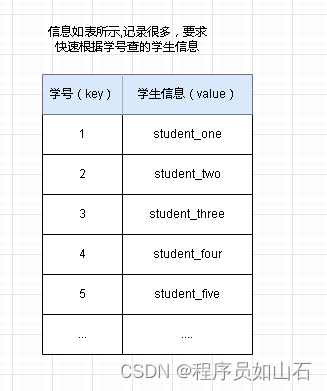1,实例
要求:快速查找学生信息

代码如下:
1 #include <map>
2 #include <iostream>
3 #include <cstring>
4 #include <string>
5 using namespace std;
6
7 int main()
8 {
9 map<int, string> mapStudent;
10 mapStudent.insert(map<int, string>::value_type(1, "student_one"));
11 mapStudent.insert(map<int, string>::value_type(2, "student_two"));
12 mapStudent.insert(map<int, string>::value_type(3, "student_three"));
13 mapStudent.insert(map<int, string>::value_type(4, "student_four"));
14
15 map<int, string>::iterator iter;
16 iter = mapStudent.find(2);
17 if(iter != mapStudent.end())
18 {
19 cout<<"key="<<iter->first<<" value="<<iter->second<<endl;
20 }
21 else
22 {
23 cout<<"Do not find"<<endl;
24 }
25 iter = mapStudent.find(12);
26 if(iter != mapStudent.end())
27 {
28 cout<<"key="<<iter->first<<" value="<<iter->second<<endl;
29 }
30 else
31 {
32 cout<<"Do not find"<<endl;
33 }
34 }
~
~
"mapInsertAndFind.cpp" 34L, 784C 已写入
root@mkx:~/learn/map1# ./mapInsertAndFind
key=2 value=student_two
Do not find
root@mkx:~/learn/map1#
很多操作,要求快,怎么才能快,用map查询速度就很快,原因,其是用 了红黑树存储的,红黑树是一种二分查找树,查找方法类似折半查看,速度非常快,复杂度是o(log2n)级别的.
2,map简介
map是STL的一个关联容器,它提供一对一的hash。
第一个可以称为关键字(key),每个关键字只能在map中出现一次;
第二个可能称为该关键字的值(value);
map以模板(泛型)方式实现,可以存储任意类型的数据,包括使用者自定义的数据类型。Map主要用于资料一对一映射(one-to-one)的情況,map內部的实现自建一颗红黑树,这颗树具有对数据自动排序的功能。在map内部所有的数据都是有序的,后边我们会见识到有序的好处。比如一个中,每个学生的学号跟他的姓名就存在著一对一映射的关系。
3,map的功能
自动建立key - value的对应。key 和 value可以是任意你需要的类型,包括自定义类型。
4,使用map
使用map得包含map类所在的头文件
#include <map> //注意,STL头文件没有扩展名.h
map对象是模板类,需要关键字和存储对象两个模板参数:
std:map<int, string> personnel;
这样就定义了一个用int作为索引,并拥有相关联的指向string的指针.
为了使用方便,可以对模板类进行一下类型定义,
typedef map<int,CString> UDT_MAP_INT_CSTRING;
UDT_MAP_INT_CSTRING enumMap;
5,map的构造函数
map共提供了6个构造函数,这块涉及到内存分配器这些东西,略过不表,在下面我们将接触到一些map的构造方法,这里要说下的就是,我们通常用如下方法构造一个map:
map<int, string> mapStudent;
6,插入元素
// 定义一个map对象
map<int, string> mapStudent;
// 第一种 用insert函數插入pair
mapStudent.insert(pair<int, string>(000, "student_zero"));
// 第二种 用insert函数插入value_type数据
mapStudent.insert(map<int, string>::value_type(001, "student_one"));
// 第三种 用"array"方式插入
mapStudent[123] = "student_first";
mapStudent[456] = "student_second";
以上三种用法,虽然都可以实现数据的插入,但是它们是有区别的,当然了第一种和第二种在效果上是完成一样的,用insert函数插入数据,在数据的 插入上涉及到集合的唯一性这个概念,即当map中有这个关键字时,insert操作是不能在插入数据的,但是用数组方式就不同了,它可以覆盖以前该关键字对 应的值,用程序说明如下:
mapStudent.insert(map<int, string>::value_type (001, "student_one"));
mapStudent.insert(map<int, string>::value_type (001, "student_two"));
上面这两条语句执行后,map中001这个关键字对应的值是“student_one”,第二条语句并没有生效,那么这就涉及到我们怎么知道insert语句是否插入成功的问题了,可以用pair来获得是否插入成功,程序如下
// 构造定义,返回一个pair对象
pair<iterator,bool> insert (const value_type& val);
pair<map<int, string>::iterator, bool> Insert_Pair;
Insert_Pair = mapStudent.insert(map<int, string>::value_type (001, "student_one"));
if(!Insert_Pair.second)
cout << ""Error insert new element" << endl;
我们通过pair的第二个变量来知道是否插入成功,它的第一个变量返回的是一个map的迭代器,如果插入成功的话Insert_Pair.second应该是true的,否则为false。
7, 查找元素
当所查找的关键key出现时,它返回数据所在对象的位置,如果沒有,返回iter与end函数的值相同。
// find 返回迭代器指向当前查找元素的位置否则返回map::end()位置
iter = mapStudent.find("123");
if(iter != mapStudent.end())
cout<<"Find, the value is"<<iter->second<<endl;
else
cout<<"Do not Find"<<endl;
#8, 刪除与清空元素
//迭代器刪除
iter = mapStudent.find("123");
mapStudent.erase(iter);
//用关键字刪除
int n = mapStudent.erase("123"); //如果刪除了會返回1,否則返回0
//用迭代器范围刪除 : 把整个map清空
mapStudent.erase(mapStudent.begin(), mapStudent.end());
//等同于mapStudent.clear()
#9,map的大小
在往map里面插入了数据,我们怎么知道当前已经插入了多少数据呢,可以用size函数,用法如下:
int nSize = mapStudent.size();
#10,map的基本操作函数:
C++ maps是一种关联式容器,包含“关键字/值”对
begin() 返回指向map头部的迭代器
clear() 删除所有元素
count() 返回指定元素出现的次数, (帮助评论区理解: 因为key值不会重复,所以只能是1 or 0)
empty() 如果map为空则返回true
end() 返回指向map末尾的迭代器
equal_range() 返回特殊条目的迭代器对
erase() 删除一个元素
find() 查找一个元素
get_allocator() 返回map的配置器
insert() 插入元素
key_comp() 返回比较元素key的函数
lower_bound() 返回键值>=给定元素的第一个位置
max_size() 返回可以容纳的最大元素个数
rbegin() 返回一个指向map尾部的逆向迭代器
rend() 返回一个指向map头部的逆向迭代器
size() 返回map中元素的个数
swap() 交换两个map
upper_bound() 返回键值>给定元素的第一个位置
value_comp() 返回比较元素value的函数